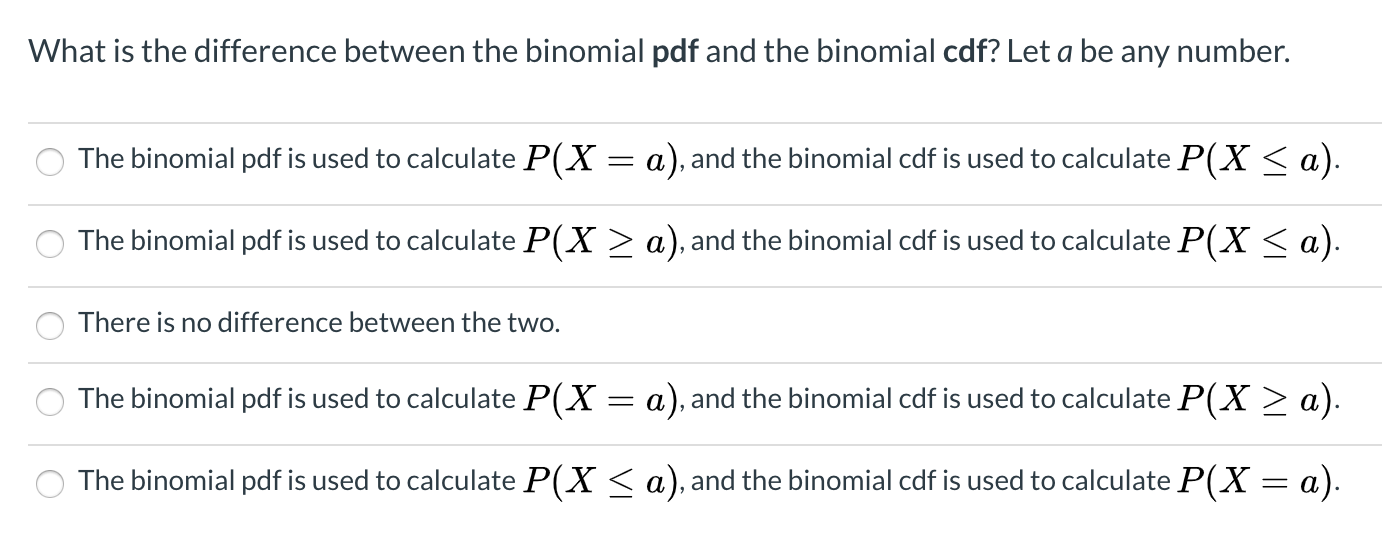
In this problem, there are 9 people selected (n = number of trials = 9).

Step 1: Go to the distributions menu on the calculator and select binompdf.

The syntax for the binomial probability density function command is binompdf(n,p,x). Be aware that this is menu item A if you have a TI-84 calculator, but it is menu item 0 on a TI-83 calculator. Likewise, where is Binomial CDF in calculator? Scroll down to binompdf( and press e. The key sequence for using the binomcdf function is as follows: If you used the data from the problem above, you would find the following: You can see how using the binomcdf function is a lot easier than actually calculating 6 probabilities and adding them up. Keeping this in consideration, what does Binomcdf mean?īinomcdf stands for binomial cumulative probability. Xaxis label= "Probability" min= 0.For example, if you were tossing a coin to see how many heads you were going to get, if the coin landed on heads that would be a “success.” The difference between the two functions is that one ( BinomPDF) is for a single number (for example, three tosses of a coin), while the other ( BinomCDF) is a cumulative probability Scatter x=prob y=q / legendlabel= "Binomial Qntl"
#Binomial pdf vs cdf series
Series x=prob y=qNormal / legendlabel= "Normal Qntl" Title "Quantiles in Tail: Binomial vs Normal (n=50 p=0.8)" * write values to SAS data set plot with SGPLOT */ create HistPlot var append close X2 = T ( do (xMin, xMax, (xMax-xMin )/ 101 ) ) X1 = T ( floor (xMin ): ceil (xMax ) ) /* evaluate binomial at integers */ XMin = mu - 4 *stddev xMax = mu+ 4 *stddev Mu = n *p /* classic approximation of binomial pdf by normal pdf */ Even when np(1-p) is fairly large, there are still sizeable differences in the values of the extreme quantiles of the distributions. The lesson is this: even though it is common to use a normal distribution to approximate the binomial, the extreme quantiles of the distributions might not be close. You can see that the normal approximation exhibits a systematic error, due to differences in the size of the binomial and normal tails. These are the values used to compute the upper control limits in a funnel plot. The following graph shows a close-up of the values of the binomial quantiles versus the normal approximation for the extreme quantiles near one. I suspect this is why David Spiegelhalter in his paper " Funnel plots for comparing institutional performance" used a rather complicated formula (in Appendix A.1.1) to interpolate the binomial quantiles in the funnel plot for proportions, rather than using a binomial approximation. These are extreme quantiles, but they are used to compute the funnel-like control limits, which are the most important feature of the plot. For example, if you are creating a funnel plot for proportions the curves on the funnel plot are computed with the quantiles 0.001, 0.025, 0.975, and 0.999. The graph shows that there is considerable error for quantiles near zero and one. QNormal = quantile("normal", prob, mu, stddev) ĭiff = q - qNormal /* error from approximating binomial quantiles */ Q = quantile("binom", prob, p, n) /* ALWAYS an integer! */ This is evident when you overlay the normal CDF on the binomial CDF, as in the following figure: Also, recall that the quantiles of a discrete distribution are integers, which provides yet another source of error when approximating a binomial quantile with a normal quantile. Although the "middles" of the two distributions agree well, there appears to be les agreement in the tails. However, the figure suggests that you need to be careful if you use a normal distribution to approximate extreme quantiles (such as 0.01 or 0.99) of the binomial distribution. * write values to SAS data set plot with SGPLOT */ X1 = T(floor(xMin):ceil(xMax)) /* evaluate binomial at integers */ Mu = n*p /* classic approximation of binomial pdf by normal pdf */
#Binomial pdf vs cdf trial
P = 0.8 /* probability of success for each trial */ N = 50 /* number of trials: better approx for 100, 200, etc.


 0 kommentar(er)
0 kommentar(er)
